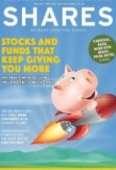Archived article
Please note that tax, investment, pension and ISA rules can change and the information and any views contained in this article may now be inaccurate.
Six ways to play the UK’s squeezed middle earners

The UK’s middle income earners are feeling the pinch. Consumer price inflation remained flat at 2.4% at the last reading but higher petrol prices and planned energy price rises point to inflation coming back with a vengeance.
Meanwhile wage growth unexpectedly softened to 2.5% in the three months to April, meaning real incomes are coming under pressure once more.
The other threat to middle earners’ financial stability and spending power is increasing automation, which could make some jobs obsolete – a recent PwC survey found that 37% of workers were worried about losing their jobs to robots.
Against this backdrop, consumers in the squeezed middle bracket might be looking for ways to make their money go further. For investors, there are a number of ways to play the theme.
TRADING DOWN
Iain Wells, co-manager of Kames UK Equity Income Fund (GB00B4ZMYG27), suggests discount retailer B&M European Value Retail (BME) might be popular among consumers who want to trade down from the mainstream supermarkets but still keep buying their favourite brands, such as Heinz tomato soup which is 27% more expensive in Tesco than B&M.
‘B&M is a beneficiary of that trend. Like-for-like numbers are positive but not significant relative to history so they are not showing a wholesale switch to B&M. But what it does have strongly in its favour is positive space growth, the fact its stores mature quickly, and the management being quite disciplined in how they invest,’ he says.
THE JOYS OF PUB FOOD
Paul Mumford, manager of Cavendish Opportunities Fund (GB00B9F9Z985), suggests pubs could do well as consumers look for cheaper food options.
‘If I was looking for value I’d look for areas that have been less adversely affected (by the squeeze on consumers), such as pub companies, especially Marstons (MARS).
‘It is on a single digit PE (price-to-earnings) ratio, a high yield, and it is trading well. I have met the management and they are confident, but the share price is bumbling along the bottom of its 12-month range.
‘The fine weather helps these companies, and the World Cup will help too. Competition has increased among restaurants – people could be drifting towards lower cost meals.’
Marstons operates more than 2,000 pubs in the UK, and its half year results in May showed a 3% rise in like-for-like sales in its taverns.
The fund manager also points to Debenhams (DEB) as a contrarian bet which could benefit from the closure of a number of House of Fraser stores, despite management never quite getting things right in the past.
The shares are down 82% over three years and are trading at a mere 16.68p following a series of profit warnings.
Mumford says: ‘Hedge funds are shorting a lot of retail names. Crispin Odey, for example, has a huge short position in Debenhams. But you could find that with House of Fraser downsizing and Poundworld having problems, a generalist company like Debenhams could start to do better.’
RETURN OF DIY?
Adrian Lowcock, investment director at Architas, suggests B&Q owner Kingfisher (KGF) as a stock idea. A recent trading update showed a 4% drop in like-for-like sales due to snow-related store closures.
The shares are at 301.8p which compares to a one-year high of 362.5p (February 2018). ‘As incomes are squeezed and especially if interest rates start to rise then we could see people revert to DIY over replacing bathrooms and kitchens or even moving house, especially if house prices start to fall,’ says Lowcock.
AJ Bell’s investment director Russ Mould names IG Design (IGR:AIM), which supplies gift wrap and greeting cards to big chains and supermarkets. Shares in the £300m market cap company are trading at 485p and have risen more than 300% in three years. ‘They’ve got state of the art equipment, they are providing their products in a price competitive fashion and the stock has done really well over the last couple of years,’ says Mould.
For investors interested in fixed income, bonds issued by frozen food chain Iceland Foods could be an interesting option for playing the squeezed middle class theme.
Iceland has a 15% share of the UK’s frozen food market, second only to Tesco. Jonathan Harris, investment director in Schroders’ fixed income team, says: ‘Middle UK earners’ incomes are likely to get squeezed over time due to efficiencies in production and automation that is threatening jobs.
‘Iceland chief executive Malcolm Walker knows his market and customer inside out. The shops themselves have no frills to them but he has tried to differentiate the products by having aspirational, good quality frozen food.
‘It’s a very easy business model to run; it is capital efficient; and, given the pressure on incomes, there is a resilient market for Iceland’s food and there may be a trading down effect from people who are earning less over time.’
HOW DO YOU GET EXPOSURE?
Listed on the Luxembourg stock exchange, Iceland’s bonds are available on AJ Bell YouInvest platform in a minimum denomination of £100,000 so this is perhaps an option only for the very wealthy.
The other way to get exposure is through Schroder High Yield Opportunities Fund (GB00B5143284) which yields 6.2% and where the Iceland bond is the second largest holding, albeit still only representing 1.5% of assets.
It is worth noting this is a fixed income investment, so you don’t share in the upside if Iceland experiences a boost in trading like you would do if you owned equity. However, stronger trading would provide piece of mind that this is a solid business and is able to keep paying the bond coupons. (HS)
Important information:
These articles are provided by Shares magazine which is published by AJ Bell Media, a part of AJ Bell. Shares is not written by AJ Bell.
Shares is provided for your general information and use and is not a personal recommendation to invest. It is not intended to be relied upon by you in making or not making any investment decisions. The investments referred to in these articles will not be suitable for all investors. If in doubt please seek appropriate independent financial advice.
Investors acting on the information in these articles do so at their own risk and AJ Bell Media and its staff do not accept liability for losses suffered by investors as a result of their investment decisions.
Issue contents
Big News
- Housebuilding review is a mixed bag for the sector
- Could post-Brexit M&A rules deter foreign investment?
- What could more liberal cannabis laws mean for investors?
- Mind Gym could be the next fast growth company to take the stock market by storm
- Are investors underestimating Costa’s growth prospects in China?

 magazine
magazine












